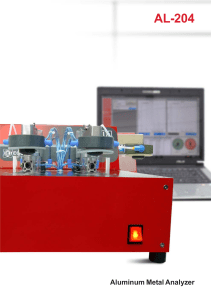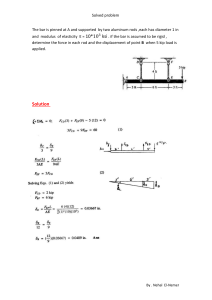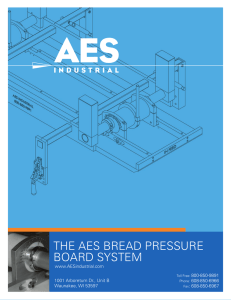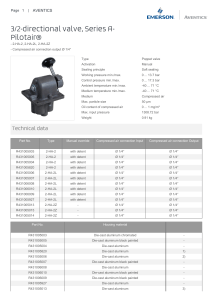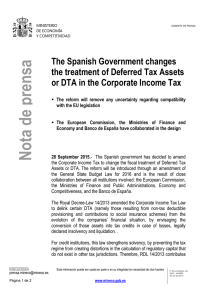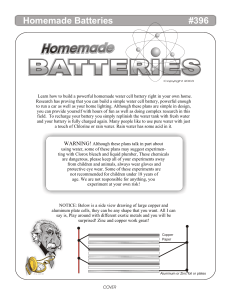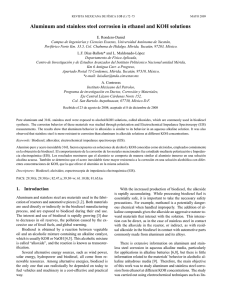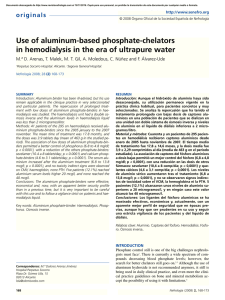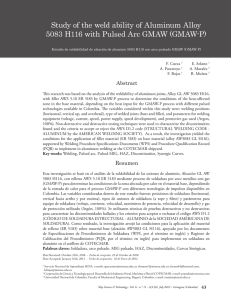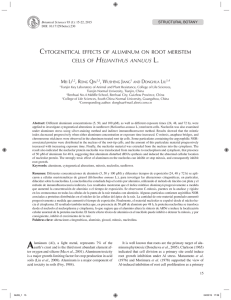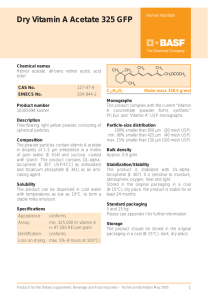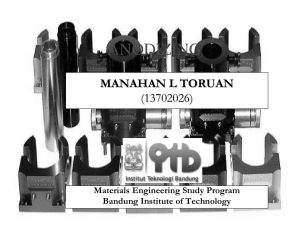New Synthetic Hydrate of Aluminum Arsenate: Synthesis & Analysis
Anuncio
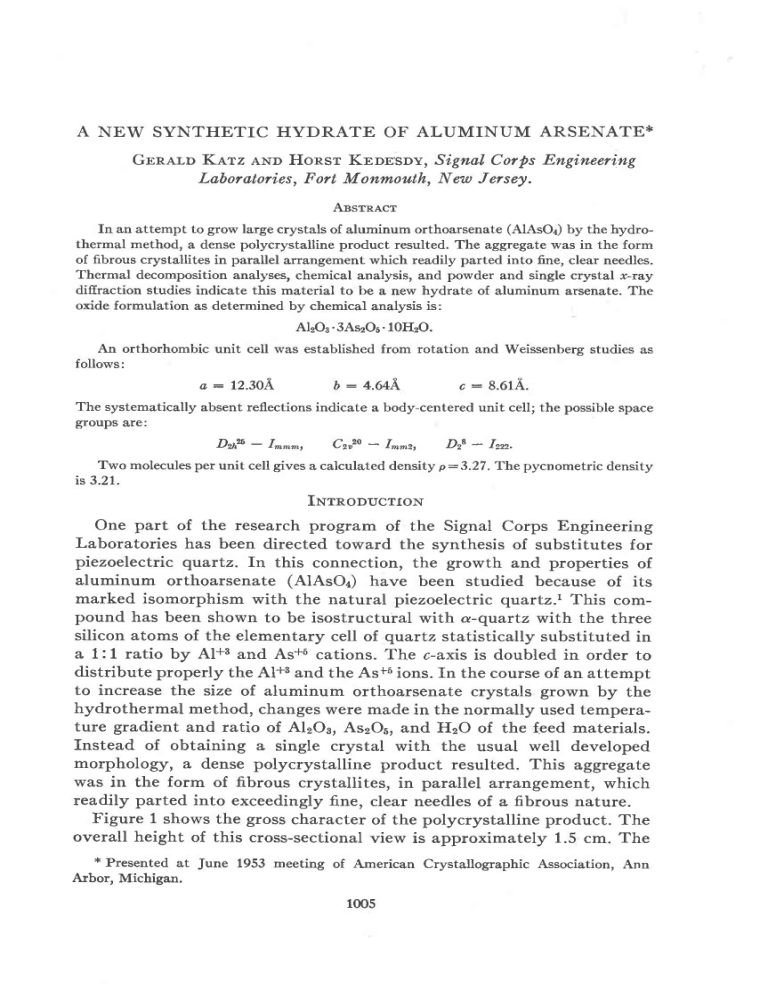
A NEW SYNTHETIC HYDRATE ARSENATE* OF ALUMINUM GBnar-n Ketz arqr Honsr Knnesov, Signal, Corps Engineering Laboratories, Fort Monmouth, New Jersey. Arsrnlcr In an attempt to grow large crystals of aluminum orthoarsenate (AlAsOd by the hydrothermal method, a dense polycrystalline product resulted. The aggregate was in the form of fibrous crystallites in parallel arrangement which readily parted into fine, clear needles. Thermal decomposition analyses, chemical analysis, and powder and single crystal r-ray difiraction studies indicate this material to be a new hydrate of aluminum arsenate. The oxide formulation as determined bv chemical analvsis is: RlrO, 'gasrOu . t0HrO. An orthorhombic unit cell was established from rotation and Weissenberg studies as follows: a : 12304 b:4.644 c : 8.614.. The systematically absent reflections indicate a body-centered unit cell; the possible space groups are: Dzn%- I^ ^, Czozo- I-*2, DzB- Izrr. Two molecules per unit cell gives a calculated density p : J.2J. The pycnometric density is 3.21. IurnooucrtoN One part of the research program of the Signal Corps Engineering Laboratories has been directed toward the synthesis of substitutes for piezoelectric qvartz. In this connection, the growth and properties of aluminum orthoarsenate (AlAsOJ have been studied because of its marked isomorphism with the natural piezoelectric qrartz.r This compound has been shown to be isostructural with ot-quartzwith the three silicon atoms of the elementary cell of quartz statistically substituted in a 1: 1 ratio by Al+r and As+5 cations. The c-axis is doubled in order to distribute properly the Al+3 and the As+5ions. In the courseof an attempt to increase the size of aluminum orthoarsenate crystals grown by the hydrothermal method, changeswere made in the normally used temperature gradient and ratio of AlzOa, As2O6,and HsO of the feed materials. Instead of obtaining a single crystal with the usual well developed morphology, a dense polycrystalline product resulted. This aggregate was in the form of fibrous crystallites, in parallel arrangement, which readily parted into exceedingly fine, clear needlesof a fibrous nature. Figure 1 shows the gross character of the polycrystalline product. The overall height of this cross-sectionalview is approximately 1.5 cm. The * Presented at June 1953 meeting of American Crystallographic fubor, Michigan. 1005 Association, Ann 1006 GERALD KATZ AND HORST KEDESDY Frc. 1. Cross-sectional view of polycrystalline aggregate. Mag. 5X electron micrograph (Fig. 2) shows the needle-like nature of the crystallites. The crystallites are generally triangular in cr.pss-sectionand frequently have a characteristic.cleavageat their tip, making an angle of approximately 110'with the needleaxis. TunnuAr- ANer,ysrs As an initial step, the r-ray diffraction powder pattern made from selected clear crystals was compared with a reference pattern of aluminum orthoarsenate. The comparison disclosedat once that the material under study was not bf the a-quartz structure (seeFig. 5). Sincespectrochemical analysis showed aluminum and arsenic to be the only cations present in structurally significant amount, the possibility was considered that the material might be a hydrate of aluminum arsenate. fn order to check this, a decomposition study was made of this compound using the differential thermal analysis method. The sample was heated from room temperature to 1,0000C. at a rate of 13' C./min. (Fig. 3) . The DTA curve showed several endothermic peaks and a very small exothermic one. S'rch a DTA curve is not uncommon for hydrous compounds such. as the hydrous aluminum phosphates.2The endothermic reactions at low temperature indicate the loss of water of crystallization; those at higher temperatures are correlated with the loss of water due to hydroxyl Frc. 2. Electron micrograph of crystallites showing their acicular nature and characteristic cleavage at the end of needles. Mag. 7,500X m x I T rtl 3 o A frl z q I m a) o TEMP_ "C Frc. 3. Difierential thermal analysis curve, heating rate-13o C./min. 1008 GERALDKATZ AND HORST KEDESDY groups in the structure. Recrystallization is indicated by exothermic reaction peaks. As will be shown from the chemical analysis, this structure is believed to have a total of 10 waters per unit cell. A rough comparison was made of the area under each of the major endothermic peaks in order to explain the various steps of the conversion to the anhydrate. The first sharp peak at 240oC. appears to be the loss of all the water of crystallization. This water is bonded by van der Waals' forces and may be expected to 65% ----:>-fi 90f o o I F I lr,l F z () bl I E UJ .L TEMP-"C curve. Fro. 4. Staticloss-in-weight be the first to Ieave the structure. This would mean that all the waters of crystallization would leave at 240" C. and the remaining 6 waters, due to hydroxyl groups, would be distributed among the other three endothermic peaks according to their relative areas; namely, 3 waters at 3 5 5 oC . , 2 w a t e r sa t 7 6 5 " C . , a n d 1 w a t e r a t 8 3 5 ' C . In order to check the DTA results concerning the water loss, a lossin-weight study of a heated sample of this aluminum arsenic compound was made (Fig. ). A powdered sample was heated at progressively higher temperatures; the specimen being held at each temperature for a three-hour period. The two steps in the curve below 300o C., which correspond to the first two endothermic peaks oI the DTA curve' indicate SYNTHETIC HYDRATE OF ALUMINUM ARSENATE 1009 ANGSTROMS 1512l Frc. 5. X-ray powder patterns taken using CuK radiation I:1.5418 A1 camera radius 57.3 mm. All patterns taken at room temperature. .4-Hydrate of aluminum arsenate-unheated. B-Hydrate after air-quenching from 300" C. C-Hydrate after air-quenching from 600o C. D-Hydrate after air-quenching from 655' C. E-Hydrate after air-quenching from 812" C. F-Hydrate after air-quenching from 1000o C. G-Aluminum orthoarsenate-pattern made frorn ground single crystal. a loss-in-weight of abofi 14/6. This compares very well with the calculated lossesof 4HrO between 100o-170" C. and 3H2O in the vicinity of 270" C. which give a theoretical cumulative loss of I37o, l7o difference is attributed to adsorbed water. Above 600' C. there was a marked increasein the weight-loss accompanied by the evolution of AszOaand Or from the sample. Since no difierentiation could be made between the water loss and the loss due to AsgOsand 02, the loss-in-weight measurements were discontinued. 1010 GERALD KATZ AND HORST KEDESDY X-Rev Drllnecrror.t PownBn ANar.vsrs To further monitor the decomposition study, Debye-Scherrer powder patterns were made of samples after being heated in the DTA unit to temperatures bracketing each reaction peak as indicated by the lettered points in Fig. 3. Each of the samples was heated at the same rate of 73" C.f min., as in the DTA run, to the desired temperature and then immediately air-quenched. The powder patterns in Fig. 5 were obtained from air quenched specimenscorresponding to the lettered points in the DTA curve (Fig.3). While the patterns of each of the quenchedspecimens have not been completely identified, the patterns which bracket the DTA peaks indicate phase transitions, some probably representing mixtures of two or more phases.It is interesting to note from the diffraction patterns that a marked change occurs in the heating interval between room temperature and 300o C.; after the evolution of the water of crystallization, the sample exhibits broader difiraction lines. Between 300' C.-600o C. there is another noticeable change reflected in the diffraction patterns. The characteristic 6 A and ?A lines of the original material re-appear with a reversal in their relative intensity. At the same time, the first appearanceof the strongest characteristic lines of AlAsOr are detected,at 3.45 h, 2.I8 A, 1.s8 h, 1Ez ]r, 1.+l A. It ;s surprisingto note that before reaching the last decomposition step the final phase has already appeared. Its intensity shows that only a small amount has been converted. Ilowever, an attempt to complete the formation of AlAsOr by heating this compound for four days at 500o C. was unsuccessful. At 655' C. there is a more noticeable appearance of the final AlAsOr phase with a gradual diminution in the intensity of the intermediate phase representedby the 6 A and 7 A Hnes.A slight shift is noted in the 5 Aline changingto 5.2 A. At8l2" C. only the 6.5 A, 5.5 A, and.2.79Ft lines are detectable in addition to those of the AlAsO4 pattern. At 1000' C. the material is completely converted to AIAsOT; its pattern can be seen to be identical to that made from a pure AlAsOa single crystal (see Fig. 5, pattern G). These results led us tentatively to designate this material as a hydrate of aluminum arsenate.A literature study of the arsenatesand phosphates has indicated the existenceof a number of mineral hydrates of the phosphates and arsenates. Table 1 summarizes various reported hydrates found in nature. Among these is a di-hydrate of aluminum orthoarsenate called mansfieldite, (AlAsOn.2H2O) reported by V. T. Allen, J. J. Fahey, and J. M. Axelrod.s llowever, no crystallographic data were given other than that the powder pattern of the material, which was intimately intergrown with kaolinite and quartz, was similar to that of scorodite SYNTHETIC HYDRATE OF ALUMINUM 1011 ARSENATE (FeAsOa'2HrO). A comparison of the powder pattern made from a sample of mansfieldite supplied by the authors with the powder pattern of this material under investigation establishedthem to be different compounds; yet mansfieldite may well be AlAsOn.2HzO. In all the hydrates reported in Table 1, there is a 1:1 atomic ratio of the metal cations. Tasln 1. Isosrnucrunela-QuanrzCoupouNos aNoMrwnner.Dr-Hvon,Lrrs or Pnospn,c.rns aNoAnspNares Formula Name SiOz AlAsOr Quartz Aluminum orthoarsenater Oo Ps s. 4.e0A s.3eA 2.65 s.ffi A 2x 3.34 3.30 s . 6 1A AIPOr Aluminum orthophosphate FePOr'2HzO FePOr'2HzO FePOe'2HsO FeAsOr'2HzO FeAsOr'2 HzO AIPO4'2HrO A1PO4.2 HrO AlAsOr.2H:O Phosphosideritea Phosphosiderite5 Strengites Scorodite6 ScoroditeT Variscite4 Metavariscitea Mansfieldite3 4 . %L 2x s . 3 0A s . 7 eL A s . 2 8A e . 7 s 1 0 . 0 6A e . s sA A 8 . 8 8A 10.26 A r0.42L 8 . e 6 e . 8A s e . s sA s . l sA e . 4 sA 2.56 s . 4 7L 8 . 6 7A 90"36',2.74 2.76 2.76 8 . 7 1 4 90"36', 2.89 2.86 8 . 6 sA 3.35 3.41 9.eSA 3.24 3.27 1 0 . 1A5 2.61 2.5 8 . s 0A 8 . 4 sA - 9 0 o 2 . 5 3 2 . 5 4 3.03 Cupurcel ANarvsrs A chemical analysis was made in order to compare the composition of the hydrate under investigation with those shown in the table. The following result was obtained: Analysis Wt'7o Al2o3 A*Or H:O rr.7 69.8 18.0 99.57o PostuJal,ed. FormuJa 1.AlrO3 3'AsrOr 10'HrO Cakulated WL7o 1 0 5. 7r.0 18.5 1o0.07o This indicatesa 1:3 ratio of Al:As. The total loss-in-weightof the sample, including the loss of water and of other volatile decomposition products, when ignited at 900oC., was found to be 64.6/6. From this it can be assumed that a decomposition has taken place with the liberation of AszOsand Oz as well as water. Taking 18/6 from the Ioss as the amount of liberated water the remainder of the loss would correspond to two moles of AsrOs. t0l2 GERALD KATZ AND HORST KEDESDY From these results the following formula for this hydrate of aluminum arsenate was proposed: Al(HzAsOq)r.2HzO. Using this formula, it can be assumed that the following decomposition takes place: 2[Al(HrAsOl)3.2HrO] - 2AlAsOr 1 | 2OzT + loHro t f 2AsrOa StqcrB Cnysrar, Awar,vsrs As described earlier, no difficulty was encountered in obtaining a fine, clear needle of the material suitable for single-crystal r-ray studies. oo4 4 or3 ro3 o02 otl 3t4 2t! 202 o 404 5r4 413 604 613 3t2 402 5t2 602 30r 4 5Ol 6 5ro 400 * ooo Fte. 6. Zero and 1st level of the reciprocal lattice from D-axis rotation. level. O-zeto level. O-lst Uniformly parallel optical extinction between crossed Nicols along the needle or fiber axis indicated this direction to be a crystallographic axis. Rbtation photographs were taken ofthiscrystal; the crystal being rotated about the fiber axis. The identity period, as determined from the rotation photograph, is 4.64 A. In addition, Weissenberg photographs were taken for the zero, first, and secondlayer lines. Figure 6 represents the reciprocal Iattice drawn to scale as found from the evaluation of the Weissenbergphotographs. The dots represent ttre zero level, the circles the first layer line. The two reciprocal axes chosenlie 90o apart giving an SYNTHETIC HYDRATE OF ALUMINUM ARSENATE 1013 Tenr,n 2. X-Rly Pomnn Dere-Hyonerr ol Ar,uurruu AtsnNetnAlzOg.3AszOo.10 IIrO Orthorhombic: a : 12. 30 i\, b : 4. 64A, c : 8. 6l A; Z : 2 PossibleSpaceGroups: D.,t25-I* *, Czn20-f^^2,Dr"-Inz Radiation:Cu-Ni filter X:1.5418 A d(meas.) VS 7.09 M_ 6.10 VS 4.33 hkt 101 2N 6.15 110 oo2 4.34 4.31 4.08 011 4.08 VS 3.69 301 3.70 M 3. 5 4 202 3. 5 3 VS 3.39 211 3.40 3.06 400 310 t12 3.08 3.O7 3.06 hkt, d(calc.)* M 2.04 600 022 204 2.05 2.04 2.03 M, B 1.963 321 1.966 M+ 1.944 512 222 1.940 r.938 M- 1.925 114 413 t.929 1.918 w 1.860 503 1.868 w 1.845 u0 ffiz 1.852 1.851 w, B 1.833 611 1.832 7.O4 M VS d(meas.) il(calc)* M 2.81 103 2.80 M 1.785 r23 1.785 S 2.51 312 N2 2.50 2.49 s 1.766 404 314 |.7634 1.762s M+ 2.M 4tl 013 2.46 2.M M 1.708 105 422 1.705 1.70r VW 2.31 501 303 020 2.37 2.35 2.32 vw, B 1.652 s2r 323 1.656 1.651 M- 1.6& 7ro l.&3 M 2.27 213 2.27 vw M- 1.622 015 1.614 2.20 t2l 2.20 M- r.593 305 1.588 2.r7 510 220 004 2.17s 2.\h 2.15 M 1.570 o24 613 1.578 1.570 M- x Calculated d spacings taken from indices of zero, lst, and 2nd level Weissenberg photographs, D-axis rotation CuK radiation. GERALD KATZ AND EORST KEDESDY 1014 Tanr,r 2-continueil 1 d(meas.) M 1.560 M+ 1.534 d(calc.)* 424 215 r.567 800 620 7t2 514 1.537 I .536 J'L t.529 r.528 ffi4 1. 5 1 5 M 1.493 703 1.499 wv, B 1.470 523 1.455 M I.M6 802 622 1.448 1.447 811 006 413 1.437 1.435 1.429 505 t.4tl M, B 1.410 M 1.370 t25 901 1.374 1.367 M 1.360 tt6 1 .363 910 325 714 813 406 316 1.311 1.310 1 .306 1.301 1 .300s I .300r w, B 1.309 vw 1.275 820 r.282 M, B 1.268 615 1.268 1.254 1.248 912 80.1 624 M, B hhl d(calc.)* r.234 1.230 r.229 1.228 r.224 M, B 1.229 903 1000 705 822 107 M, B 1.203 525 516 226 r.205 1.198 1.197 ww 1.187 0r7 1002 1.189 1.183 M, B 1.176 1011 307 606 1.178 r.r77 1.176 M, B 1.153 0351 1.151 w+ r.r39 426 1.134 w 1.122 914 1.120 w, B 1.115 815 417 1101 1.113 1.109 1.109 w, B 1.098 824 507 1013 1.101 1.100 1.098 w, B 1.084 1110 1020 725 r27 716 1.087 1.086? 1.084 1.083 1.081 w, B 1.069 905 1004 208 1 .07| 1.068 1.060 1.053 ttlz 327 806 626 1.054 1.050 r.049 1.04& I.JJJ 1.519 r.437 d(meas.) I .561 M w 1 r.25r I .250 M, B t Reflection outside sphere of reflection for b-axis rotation. B broad diffraction line. SYNTHETIC EYDRATE OF ALUMINUM ARSENATE 1015 orthorhombic real unit cell. The unit cell dimensions were determined to be: a : 72.304 b :4.e4, c : 8.614 Table 2 is an evaluation of the powder pattern using the lattice parameters obtained from the rotation and Weissenberg data. The indices for the calculatedd spacingswere obtained from the zero,1st, and 2nd Ievel Weissenberg photographs. The d spacings for indices outside the sphere of reflection for D-axis rotation using Cu/Ni filtered radiation were not calculated. Using the previously postulated chemical formula of Al(HzAsOr)a .2H2O together with the unit cell dimensions, the density can be calculated M : M.2.1.65 assumingZ:2, Mol. weight Z : Moles per unit cell V : Unit cell volume in A3 we get:o": 485.70x2x1.65 r23ox4.64x8.61 Due to the characteristic fibrous nature of the crystals, it was necessary to powder the material in order to obtain accurate density measurements. The pycnometric density determined using toluene was 3.21. Figure 7 shows the indexing of the reciprocal lattice of the zero and 1st level directly on the Weissenbergphotographs. The 2nd level was a repetition of the zero level. The following reflections were found to be systematicalty absent: hht with h+k+t:2nlI 001with l:2nll /200with hol with jkl with h:2n*l hll:2nll h*l:2ntl This indicates a body-centered unit cell. Considering the assumed chemical formula of the compound and the extinction rules found, the possiblespacegroups are: D21,25-f ^ *, C2,20-I*2, D28-1222.8 8 R. Pepinsky, private communication April 20, 1954, Penn. State University, hydrate of aluminum arsenate found to be clearly piezoelectric. This data, which is in agreement with the detection of optical activity and triboluminescence, eliminates the centrosymmetric space group D21,x-I^^*. 1016 GERALD KATZ AND HORST KEDESDY Frc. 7. Indexed Weissenberg photographs. A-zero level. B-lst level. SYNTHETIC HYDRATE OF ALUMINUM ARSENATE IOIT This paper has described the identification and characterization and preliminary structure postulation of a new synthetic hydrate of aluminum arsenate. A complete structure determination has been started. Acrr.rowr,rncMENTS The authors wish to express their indebtednessto the following: Mr. J. M. Stanley for growing the sample; Mr. S. delVecchio for performing the chemical analysis; Mr. L. Toman for obtaining the DTA data; Mr. R. Clarke for the densitv measurement. Rnrnn-nNcts 1. Ma.cn,rrscnr<r, F., The crystal structure of aluminum arsenateAlAsOr: Zeit. Krist., gO, 314-321(1935). 2. Mexr-v, R. L., Jn.,The difierential thermal analysisof certainphosphates:, Am. Minerol,., 35, 108-115(1950). 3. Ar,r,nr, V. T., Flnrv, J. J. , aNo Axrrnoo, J. M., Mansfieldite, a new arsenate,the aluminum analogueof scorodite,and the mansfieldite-scorodite series:Am. Mineral.,33, r22-r34 (1948). 4. McCowrnr,r,, D., Clinobarrandite and isodimorphousseries,variscite-metavariscite: Am. Mineral., 25, 7l9-7 25 (lg40). 5. SrnuNz,H., aNo Szrn6rl,v, K. V., Isomorphismbetweenmetavariscite,variscite,phosphosiderite,and strengite:Zentral,.Mineral,ogie,Geol,.,Pal,aont.,A, 272-278 (1939). 6. Korronos, P., Ertr Prakt. Acad..Athenes,13,337 (1938). 7. Krnrvnua, R., aNo Sarunnr, K., The crystalstructureof scorodite:X-Sez (Rays),5, 8s-88 (1949). Manuscript reeei.veil Aug. 31, 1953
